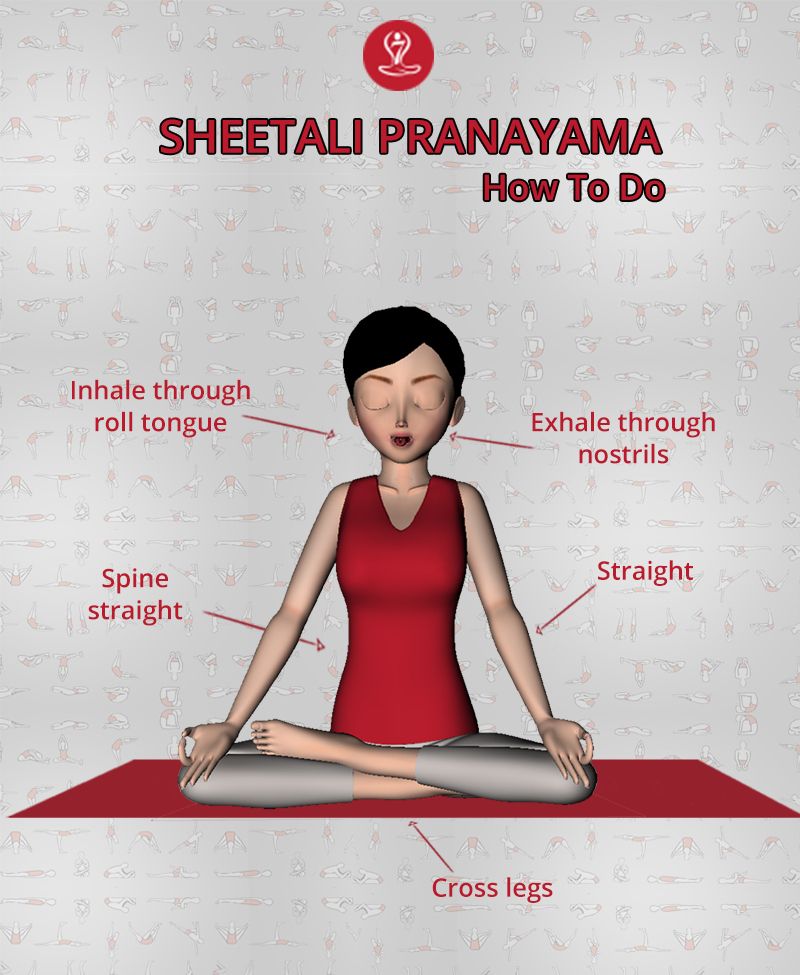Sheetali is a Sanskrit word derived from the root word sheet that means ‘cold.’ Also, the word Sheetal means something that is soothing, calm, and relaxing. The benefits of sheetali pranayama are many. Learn how to perform this correctly.
Mention in Scriptures
In Hatha Pradipika, Svātmārāma talks about this practice in the following verses, revealing the method, and benefits associated with this practice.

Translation: “As in the above (Sîtkári), the tongue to be protruded a little out of the lips, when the air is drawn in. It is kept confined, as before, and then expelled slowly through the nostrils” [1].

Translation: “This Śîtalî Ḳumbhikâ cures colic, (enlarged) spleen, fever, disorders of bile, hunger, thirst, and counteracts poisons” [1].
Procedure
Beginner Method
- Sit in a comfortable meditative posture. You can sit on a chair or in padmasana or siddha asana.
- Your spinal cord and head should be erect, and the hands should rest on the knees in chin or jnana mudra.
- Close your and eyes and try to relax your whole body.
- Next, extend your tongue outside your mouth as far as you can without straining.
- Roll the sides of your tongue such that it forms the shape of a tube. Now inhale and draw the breath in through this tube.
- After the end of your inhalation, draw your tongue inside, close your mouth and exhale through the nose. This completes one round.
- While sucking the breath in through the tongue, the sound produced should be similar to a rushing wind. You will feel an icy coldness on tongue and the roof of the mouth.

Advance Method
The advance method is similar to the advance method of Sheetkari Pranayama
- Repeat the steps as performed in Beginner Method, but after the inhalation, hold your breath.
- Then perform Jalandhara bhanda and Moola bandha
- Hold these two bandhas as long as you feel comfortable.
- First release Moola bandha and then Jalandhara bhanda and exhale the breath out slowly through your nose with your head straight.
- Repeat the above process 10 to 20 times. This completes 1 round.
Duration
Start from 9 rounds. Slowly increases the number of rounds and the duration of each inhale and exhale. After a week, 15 rounds is sufficient. In case of very hot weather, up to 60 rounds can be performed.
Time of Practice
Sheetali Pranayama can be performed any time during the day. It is preferable to perform it after asana practice or other yogic practice like bhastrika as the body is heated, and this helps in cooling down.
Sheetali Pranayama Precautions
The precautions of this pranayama are almost similar to the precautions of Sheetkari Pranayama.
- This pranayama should not be performed during cold weather as it reduces the body temperature.
- It should not be practiced in a dirty and polluted atmosphere. Since the air breathed through the mouth bypasses the natural filtration mechanism of the nose, direct exposure to dirty air could harm the lungs.
- People suffering from the following diseases should not perform this pranayama:
- Low blood pressure
- Asthma
- Bronchitis
- Excessive Mucus
- Heart disease (can practice less rounds, also without breath retention)
- People suffering from chronic constipation or gastric problems should avoid this practice as this pranayama reduces the heat produced in the digestive system.
Sheetali Pranayama Benefits
The benefits of Sheetali are similar to Sheetkari Pranayama
- It helps in calming and cooling down the body and the mind.
- It influences the centers of the brain linked with biological drives and desires. One is able to have more control over sexual desires and vital energy.
- It helps in cooling emotional excitation and anger.
- It can be used before sleeping to tranquilize the mind and help in insomnia.
- It helps in unblocking the flow of prana through the body.
- It helps in reducing blood pressure.
- It helps in reducing acidity and hyperacidity
- It helps in reducing hunger pangs
- It helps in balancing excessive pitta dosha
- It helps in relieving anxiety and hypertension.
References
- (All the verse translations in the article are by Pancham Sinh) Book: Hatha Yoga Pradipika Translated by Pancham Sinh.
- Book: Asana Pranayama Mudra Bandha by Swami Satyananda Saraswati
- Book: The science Of Pranayama by Sri Sivananda.
- Book: Light on Pranayama by B.K.S Iyengar.
- Research Paper: Impact of Sheetali and Sheetkari Pranayama on the Topographic Mapping of the Brain Waves [link].
